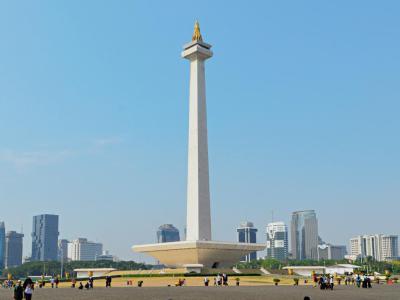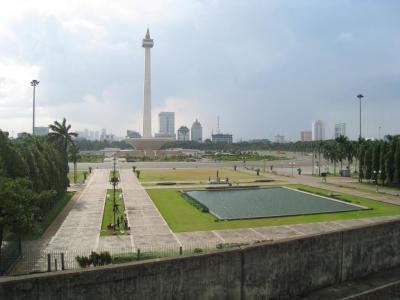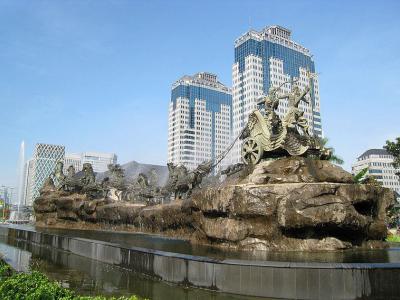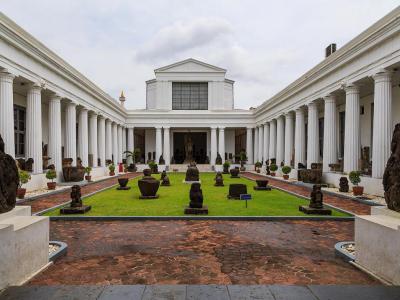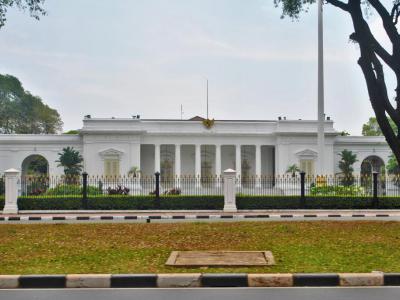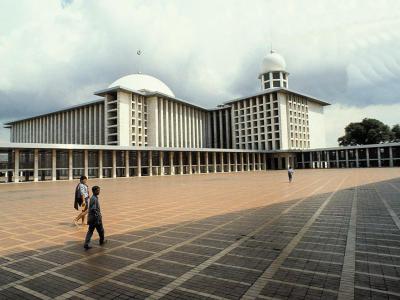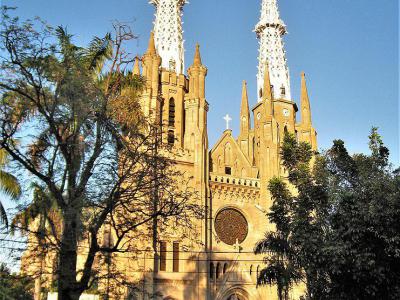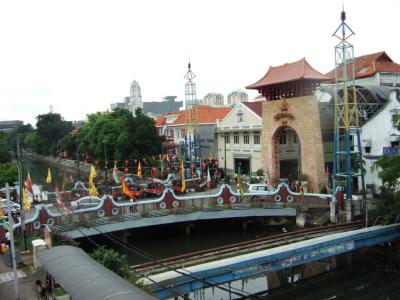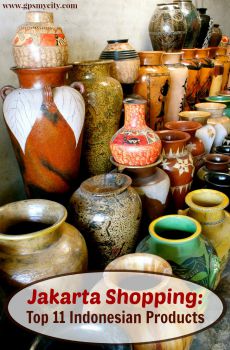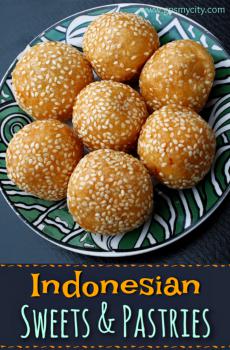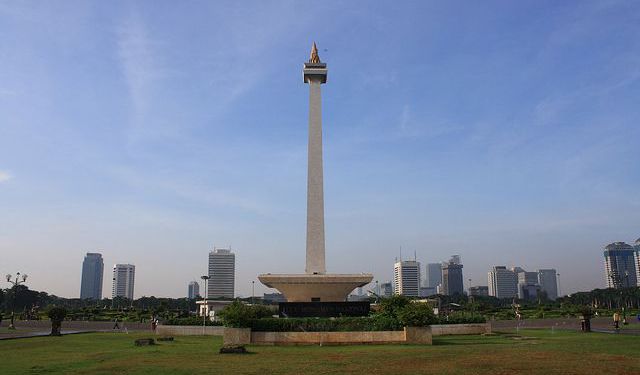
Jakarta Introduction Walking Tour (Self Guided), Jakarta
The capital of Indonesia, Jakarta, is a massive, fast-paced metropolis and a melting pot of cultures – Asian and European – that historically coexisted and imprinted their influence on the city's architecture, language, cuisine, and lifestyle. The local Istiqlal Mosque is the largest Islamic temple in Southeast Asia, while the Neo-Gothic Gereja Katedral, also known as the Jakarta Cathedral or Cathedral of St Mary of the Assumption, is one of Jakarta's most recognizable landmarks.
"A city that is always moving, always changing, always growing," they say, Jakarta is not only the political and economic heart of Indonesia but also one of the most populous cities in Southeast Asia.
Its history started in the 4th century, then a small town called Sunda Kelapa. By the 13th century, the city had grown to become the capital of the Hindu Kingdom of Sunda which allied with the Portuguese who built a seaport here, in 1522. Five years later, the city was conquered by the Muslim Sultanate of Banten and subsequently renamed "Jakarta" which comes from a combination of two Sanskrit words: jaya (victorious) and krta (accomplished). The name was given by the Javanese Prince Jayawikarta, whose army ultimately defeated and drove the Portuguese away.
In 1619, the Dutch East India Company established a settlement in Jakarta, which later became the center of the Dutch colonial administration, in the 18th and 19th centuries. During World War II, Jakarta was occupied by the Japanese, and after the war, became the capital of independent Indonesia, in 1949. A 132-meter-high National Monument, the symbol of Indonesia's independence is now one of the city's top attractions.
Jakarta is also known for its shopping malls, ranging from luxury to budget-friendly options, and a rather diverse food scene, featuring both traditional Indonesian cuisine and international fare. A famous chef and TV host once remarked that "Jakarta is a city that never stops eating."
Indeed, Jakarta is a city of contrasts that can surprise you at every turn. If you love surprises and are keen to experience first-hand the complexity of Jakarta, with its mix of modernity and tradition, rapid growth and change, you may certainly benefit from this self-guided introductory walk.
"A city that is always moving, always changing, always growing," they say, Jakarta is not only the political and economic heart of Indonesia but also one of the most populous cities in Southeast Asia.
Its history started in the 4th century, then a small town called Sunda Kelapa. By the 13th century, the city had grown to become the capital of the Hindu Kingdom of Sunda which allied with the Portuguese who built a seaport here, in 1522. Five years later, the city was conquered by the Muslim Sultanate of Banten and subsequently renamed "Jakarta" which comes from a combination of two Sanskrit words: jaya (victorious) and krta (accomplished). The name was given by the Javanese Prince Jayawikarta, whose army ultimately defeated and drove the Portuguese away.
In 1619, the Dutch East India Company established a settlement in Jakarta, which later became the center of the Dutch colonial administration, in the 18th and 19th centuries. During World War II, Jakarta was occupied by the Japanese, and after the war, became the capital of independent Indonesia, in 1949. A 132-meter-high National Monument, the symbol of Indonesia's independence is now one of the city's top attractions.
Jakarta is also known for its shopping malls, ranging from luxury to budget-friendly options, and a rather diverse food scene, featuring both traditional Indonesian cuisine and international fare. A famous chef and TV host once remarked that "Jakarta is a city that never stops eating."
Indeed, Jakarta is a city of contrasts that can surprise you at every turn. If you love surprises and are keen to experience first-hand the complexity of Jakarta, with its mix of modernity and tradition, rapid growth and change, you may certainly benefit from this self-guided introductory walk.
How it works: Download the app "GPSmyCity: Walks in 1K+ Cities" from Apple App Store or Google Play Store to your mobile phone or tablet. The app turns your mobile device into a personal tour guide and its built-in GPS navigation functions guide you from one tour stop to next. The app works offline, so no data plan is needed when traveling abroad.
Jakarta Introduction Walking Tour Map
Guide Name: Jakarta Introduction Walking Tour
Guide Location: Indonesia » Jakarta (See other walking tours in Jakarta)
Guide Type: Self-guided Walking Tour (Sightseeing)
# of Attractions: 8
Tour Duration: 2 Hour(s)
Travel Distance: 4.1 Km or 2.5 Miles
Author: jenny
Sight(s) Featured in This Guide:
Guide Location: Indonesia » Jakarta (See other walking tours in Jakarta)
Guide Type: Self-guided Walking Tour (Sightseeing)
# of Attractions: 8
Tour Duration: 2 Hour(s)
Travel Distance: 4.1 Km or 2.5 Miles
Author: jenny
Sight(s) Featured in This Guide:
- Monas (National Monument)
- Lapangan Merdeka (Freedom Square)
- Arjuna Wijaya Statue
- National Museum
- Istana Merdeka (Presidential Palace)
- Istiqlal Mosque
- Gereja Katedral (Cathedral Church)
- Jalan Pasar Baru (New Market Street)
1) Monas (National Monument) (must see)
Designed by architects Frederich Silaban (the same architect who designed Istiqlal Mosque) and R.M. Soedarsono and built during the first Indonesian president, Sukarno, the Monas or National Monument is meant to commemorate the Indonesian people who fought for the national independence. The monument encapsulates Indonesian symbols such as the rice pestle (the upper part of the monument) and the mortar (the lower part of the monument), the numbers 17, 8 and 45 (August 17th, 1945 – the date when Indonesia’s Independence was proclaimed) and a gold plated flame called the Independence Flame, a pledge that the country will always remain an independent territory.
The monument measures 132 meters in height and features a larger part at the bottom (interpreted as the mortar or the yoni – female reproductive organs) and a high upper part (representing the pestle or the lingga – the phallus). In traditional beliefs, the monument is also a sign of people’s fertility and its power of surviving throughout the time.
The lower part hosts a History Museum where tourists can admire sequences of Indonesia’s history, starting with prehistory and ending with the declaration of Independence; there is also an Independence Hall where a copy of the Proclamation of Indonesia’s Independence is displayed.
The top part offers tourists a panoramic view over Jakarta. In sunny days, the ocean and Salak Mountain can be admired from the Observation Platform located on top of the monument, near the gold plated flame.
The monument measures 132 meters in height and features a larger part at the bottom (interpreted as the mortar or the yoni – female reproductive organs) and a high upper part (representing the pestle or the lingga – the phallus). In traditional beliefs, the monument is also a sign of people’s fertility and its power of surviving throughout the time.
The lower part hosts a History Museum where tourists can admire sequences of Indonesia’s history, starting with prehistory and ending with the declaration of Independence; there is also an Independence Hall where a copy of the Proclamation of Indonesia’s Independence is displayed.
The top part offers tourists a panoramic view over Jakarta. In sunny days, the ocean and Salak Mountain can be admired from the Observation Platform located on top of the monument, near the gold plated flame.
2) Lapangan Merdeka (Freedom Square) (must see)
Lapangan Merdeka or Freedom Square is the largest and most popular square in Jakarta. Placed in central Jakarta, the Merdeka Square measures one square kilometer and it is divided into four major areas corresponding to the four cardinal points. Thus, Taman Medan Merdeka Utara is located in the North and features a bust of Chairil Anwar (local poet) and an equestrian statue of Diponegoro (Javanese prince who opposed Dutch colonization). The Taman Medan Merdeka Timur is located in the East and features a statue of Kartini (Indonesian heroine) and a reflecting pond. On the South there is the Taman Medan Merdeka Selatan where tourists can admire a spotted deer park and a plant collection representing 33 Indonesian provinces. The parking lots and food stalls are concentrated here, too. Last but not least, the Taman Medan Merdeka Barat is located on the Western part and features the famous musical fountain. Magical shows are held here every night during the weekends, when the fountain is illuminated.
In the center of Lapangan Merdeka stands the National Monument, while numerous other touristic and administrative buildings trim the square. Merdeka Palace, Istiqlal Mosque and the National Museum of Indonesia are only few of the buildings with important touristic value located near Merdeka Square.
In the center of Lapangan Merdeka stands the National Monument, while numerous other touristic and administrative buildings trim the square. Merdeka Palace, Istiqlal Mosque and the National Museum of Indonesia are only few of the buildings with important touristic value located near Merdeka Square.
3) Arjuna Wijaya Statue
Situated in the heart of Jakarta's business district, the Arjuna Wijaya Statue stands as an iconic symbol of Indonesian heritage, culture, and national pride. Positioned at the bustling intersection of Jalan MH Thamrin and Jalan Medan Merdeka, this impressive monument, created in 1987, is composed of copper and stands 5 meters tall and 23 meters long, with a weight of 3,600 pounds.
Drawing inspiration from the Mahabharata—one of the two major Sanskrit epics of ancient India in Hinduism—the statue depicts the legendary figure Arjuna, one of the Five Pandava brothers, riding on a horse-drawn carriage and defeating Karna in the Bharata Yuda War. This powerful scene was brought to life by Indonesian sculptor Nyoman Nuarta, who designed the Arjuna Wijaya Statue as a poignant reminder of Indonesia's struggle for independence.
Erected under President Soeharto's direction, the statue serves as a tribute to Indonesia's hard-earned freedom, with the hope that it would inspire future generations to defend their homeland. Furthermore, Nuarta's interpretation of the monument highlights its role as a symbol of impartial law enforcement, drawing inspiration from the story of a statue depicting Arjuna's battle against his brother, the Duke of Karna.
Visitors to Jakarta should make it a point not to miss the Arjuna Wijaya Statue. As a vibrant symbol of Indonesia's history, cultural diversity, and national pride, it serves as a captivating reminder of the resilience, determination, and unity that define the nation and its people.
Drawing inspiration from the Mahabharata—one of the two major Sanskrit epics of ancient India in Hinduism—the statue depicts the legendary figure Arjuna, one of the Five Pandava brothers, riding on a horse-drawn carriage and defeating Karna in the Bharata Yuda War. This powerful scene was brought to life by Indonesian sculptor Nyoman Nuarta, who designed the Arjuna Wijaya Statue as a poignant reminder of Indonesia's struggle for independence.
Erected under President Soeharto's direction, the statue serves as a tribute to Indonesia's hard-earned freedom, with the hope that it would inspire future generations to defend their homeland. Furthermore, Nuarta's interpretation of the monument highlights its role as a symbol of impartial law enforcement, drawing inspiration from the story of a statue depicting Arjuna's battle against his brother, the Duke of Karna.
Visitors to Jakarta should make it a point not to miss the Arjuna Wijaya Statue. As a vibrant symbol of Indonesia's history, cultural diversity, and national pride, it serves as a captivating reminder of the resilience, determination, and unity that define the nation and its people.
4) National Museum (must see)
The National Museum of Indonesia, also known to tourists as the Gedung Gajah (Elephant Building) because of the elephant statues in the front yard, hosts the finest historical, archeological, numismatic, ethnological and geographical exhibits from Indonesia and some of the completest collections from South Asia. The Museum boasts about 61,500 anthropological and prehistoric exhibits and over 5,000 archeological exhibits. The artifacts are mostly gathered from Indonesia, but other Asian countries are represented through rare objects too.
Among the highly valued collections one must notice the ceramic collection (with Indonesian exhibits as well as rare Chinese, Vietnamese and Japanese artifacts), the stone sculpture collection (with exhibits dating back from prehistoric period), the treasure rooms (featuring ancient gold and silver objects), the prehistory collection (exploring the beginnings of the Indonesian people), the historical relics collection (containing objects – mainly furniture – from the Dutch colonization period) and the ethnography collection. Other collections include numismatics, textile and bronze items.
Recently, the 1868 building proved too small for all the precious artifacts, and a new wing has been built following the original architecture. The new wing features seven levels with only four hosting permanent exhibits. The four levels are structured on themes (man and environment; knowledge, technology and economy; social organization and settlement patterns, and treasures and ceramics).
Among the highly valued collections one must notice the ceramic collection (with Indonesian exhibits as well as rare Chinese, Vietnamese and Japanese artifacts), the stone sculpture collection (with exhibits dating back from prehistoric period), the treasure rooms (featuring ancient gold and silver objects), the prehistory collection (exploring the beginnings of the Indonesian people), the historical relics collection (containing objects – mainly furniture – from the Dutch colonization period) and the ethnography collection. Other collections include numismatics, textile and bronze items.
Recently, the 1868 building proved too small for all the precious artifacts, and a new wing has been built following the original architecture. The new wing features seven levels with only four hosting permanent exhibits. The four levels are structured on themes (man and environment; knowledge, technology and economy; social organization and settlement patterns, and treasures and ceramics).
5) Istana Merdeka (Presidential Palace)
Istana Merdeka or Presidential Palace is part of the administrative complex located in central Jakarta, Indonesia. The Merdeka Palace, along with Istana Negara, has functioned as administrative and residential building for the supreme forces of the state. Built in the 19th century, Istana Merdeka (originally known under the name of Koningsplein Paleis) has accommodated 15 Dutch governor-generals, 3 Japanese military commanders and one president (President Soekarno). Succeeding presidents used Merdeka as residence only occasionally. Yet, the palace is still used for official reunions, receiving the Letter of Credence from foreign embassies, national and international congresses, welcoming foreign officials and heads of state and other formal events.
Apart from administrative role, the neoclassic building has also a highly important role in Indonesia’s history as it is the place where the country independence was signed. The ceremony of lowering the Dutch flag and rising the Indonesian one was held in front of the Palace, thousands of people yelling “Merdeka! Merdeka!” (which means freedom).
The building’s exterior can be admired from the Merdeka Square, while the inside of the building can be visited under strict rules of security. Special checking will be performed and only persons dressed decently will be allowed inside. Women wearing trousers are not granted access into the building.
Apart from administrative role, the neoclassic building has also a highly important role in Indonesia’s history as it is the place where the country independence was signed. The ceremony of lowering the Dutch flag and rising the Indonesian one was held in front of the Palace, thousands of people yelling “Merdeka! Merdeka!” (which means freedom).
The building’s exterior can be admired from the Merdeka Square, while the inside of the building can be visited under strict rules of security. Special checking will be performed and only persons dressed decently will be allowed inside. Women wearing trousers are not granted access into the building.
6) Istiqlal Mosque (must see)
Boasting the world's most numerous community of Muslims (90% of the country’s population declared Islam as their religion), Indonesia is also home to the largest Mosque in the South East Asia. The Istiqlal Mosque was built between 1961 and 1978, after a project designed by Frederich Silaban, whose main theme was Ketuhanan or Divinity.
The Mosque was raised as a sign of gratitude for God’s help in obtaining Indonesia’s independence, hence its name, Istuqlal, which means “Independence” in Arabic.
Located in the city center, almost opposite the National Cathedral, the Mosque is also meant to be a symbol of peace and religious tolerance. Both monuments are placed near Merdeka Square, suggesting a total harmony between the mundane and the spiritual world.
An architectonic masterpiece, the Mosque can accommodate approx. 120,000 people in all praying areas. The building features 5 stories, a praying area covered with a 45m dome and a main entrance covered with a 10m dome. The minaret is 90 meters high and it is entirely covered in white marble. When not fully occupied, the praying areas are meant for religious lessons and instruction. Apart from the praying areas, the Mosque also features numerous bazaars, spaces for conferences and religious events. During Ramadan, pilgrims receive meals and accommodation inside the Mosque.
Visitors can admire the marble-covered exterior from different parts of the city, but can also take a tour of the Mosque. Non-Muslim visitors are not allowed inside the main praying hall, though.
The Mosque was raised as a sign of gratitude for God’s help in obtaining Indonesia’s independence, hence its name, Istuqlal, which means “Independence” in Arabic.
Located in the city center, almost opposite the National Cathedral, the Mosque is also meant to be a symbol of peace and religious tolerance. Both monuments are placed near Merdeka Square, suggesting a total harmony between the mundane and the spiritual world.
An architectonic masterpiece, the Mosque can accommodate approx. 120,000 people in all praying areas. The building features 5 stories, a praying area covered with a 45m dome and a main entrance covered with a 10m dome. The minaret is 90 meters high and it is entirely covered in white marble. When not fully occupied, the praying areas are meant for religious lessons and instruction. Apart from the praying areas, the Mosque also features numerous bazaars, spaces for conferences and religious events. During Ramadan, pilgrims receive meals and accommodation inside the Mosque.
Visitors can admire the marble-covered exterior from different parts of the city, but can also take a tour of the Mosque. Non-Muslim visitors are not allowed inside the main praying hall, though.
7) Gereja Katedral (Cathedral Church) (must see)
Jakarta Cathedral Church or Gereja Santa Maria Pelindung Diangkat Ke Surga (the Church of Our Lady of Assumption) is a Catholic Cathedral built in neo-classical style. Located near the Merdeka Palace, at No. Jl.Katedral. 2, the Cathedral is an elegant, yet grandiose establishment featuring cast iron steeples, red brick body, teak wood shelter and stone pillars in Roman styles. It measures 60 meters in height and 10 in width, with an extension of 5 meters on each aisle.
The cathedral was finished in 1901, after a decade of halts due mainly to financial problems. Labeled as the largest and most beautiful Christian establishment in Indonesia, the Cathedral is beautifully decorated with paintings and religious sculptures. Above the main entrance, there is a round, colored glass décor symbolizing Virgin Mary. A large Neo-Gothic style organ decorates the southern side of the cathedral.
The building is divided into two stories: the ground floor is dedicated to masses and religious events, while the second floor, originally designed to hold the choir, hosts a small religious museum. Visitors can admire here robes, religious books and relics of the Catholic rituals. In the back of the church there is a small candle factory which can also be visited.
The cathedral was finished in 1901, after a decade of halts due mainly to financial problems. Labeled as the largest and most beautiful Christian establishment in Indonesia, the Cathedral is beautifully decorated with paintings and religious sculptures. Above the main entrance, there is a round, colored glass décor symbolizing Virgin Mary. A large Neo-Gothic style organ decorates the southern side of the cathedral.
The building is divided into two stories: the ground floor is dedicated to masses and religious events, while the second floor, originally designed to hold the choir, hosts a small religious museum. Visitors can admire here robes, religious books and relics of the Catholic rituals. In the back of the church there is a small candle factory which can also be visited.
8) Jalan Pasar Baru (New Market Street)
Jalan Pasar Baru in Jakarta is a popular market that has been around for quite some time, despite its name translating to "new market" in English. It is well-known for its affordable shopping options, which makes it a must-visit attraction for both locals and tourists. The market is located within walking distance of the Monas, Indonesia's National Monument, making it an easy and convenient place to shop.
Jalan Pasar Baru is the main street that makes up the market, and it is packed with a variety of shops selling a wide range of products. Whether you're looking for fashion products, shoes, bags, salon equipment, spices, T-shirts, sporting goods or electronics, you'll find it all here.
One of the most popular items at Pasar Baru is textiles, and you'll find a wide range of options at the market. The market has a noticeable Indian influence, which is reflected in the products and services available here. If you have some time, it's also a great place to get a dress or suit made at one of the tailoring shops.
As you make your way from the southern section of Jalan Pasar Baru to the northern area, you'll notice a transition from outdoor individual shops to multi-story shopping complexes such as Harco Pasar Baru. The southernmost section of Jalan Pasar Baru has some sporting shops with a wide selection of badminton gear, while the northern section has more textile and craft shops.
In the area of Harco Pasar Baru, you'll find more electronics and various street-side fruit vendors. With its diverse offerings, Jalan Pasar Baru is a great place to explore and shop in Jakarta.
Jalan Pasar Baru is the main street that makes up the market, and it is packed with a variety of shops selling a wide range of products. Whether you're looking for fashion products, shoes, bags, salon equipment, spices, T-shirts, sporting goods or electronics, you'll find it all here.
One of the most popular items at Pasar Baru is textiles, and you'll find a wide range of options at the market. The market has a noticeable Indian influence, which is reflected in the products and services available here. If you have some time, it's also a great place to get a dress or suit made at one of the tailoring shops.
As you make your way from the southern section of Jalan Pasar Baru to the northern area, you'll notice a transition from outdoor individual shops to multi-story shopping complexes such as Harco Pasar Baru. The southernmost section of Jalan Pasar Baru has some sporting shops with a wide selection of badminton gear, while the northern section has more textile and craft shops.
In the area of Harco Pasar Baru, you'll find more electronics and various street-side fruit vendors. With its diverse offerings, Jalan Pasar Baru is a great place to explore and shop in Jakarta.
Walking Tours in Jakarta, Indonesia
Create Your Own Walk in Jakarta
Creating your own self-guided walk in Jakarta is easy and fun. Choose the city attractions that you want to see and a walk route map will be created just for you. You can even set your hotel as the start point of the walk.
Jakarta's Colonial Buildings
Throughout the centuries, the European powers, particularly the Dutch who colonized Indonesia from the 1800s until 1945, left their mark on Jakarta. At one time known as Batavia, the de-facto capital of the Dutch East Indies, today Jakarta boasts a wealth of old-time structures, featuring a fascinating blend of European and Javanese design influences.
One of the most prominent areas to explore... view more
Tour Duration: 2 Hour(s)
Travel Distance: 2.7 Km or 1.7 Miles
One of the most prominent areas to explore... view more
Tour Duration: 2 Hour(s)
Travel Distance: 2.7 Km or 1.7 Miles
Useful Travel Guides for Planning Your Trip
Jakarta Shopping Guide: Top 11 Indonesian Products
The world's largest Muslim-populated country, Indonesia is also a mecca for tourists, drawing millions each year to her thousands of volcanic islands scattered between the Pacific and Indian oceans. The country's ethnic diversity has given rise to the lavish and colorful arts and...
Indonesian Sweets and Pastries
Spread across an archipelago of islands accommodating hundreds of ethnicities speaking many different languages, Indonesia is a cluster of just as many culinary traditions. And just as any other Asian culinary, Indonesian cuisine can't be imagined without a dollop of sweetness. Some of the...
The Most Popular Cities
/ view all
